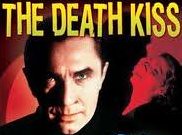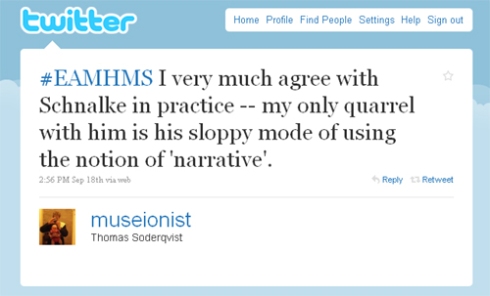 One of my British colleagues just mailed me:
One of my British colleagues just mailed me:
I feel, sadly, that over here museological thought is constrained by narrow social and pedagogical objectives.
Couldn’t agree more. Didactics is a death kiss to museums!
 One of my British colleagues just mailed me:
One of my British colleagues just mailed me:
I feel, sadly, that over here museological thought is constrained by narrow social and pedagogical objectives.
Couldn’t agree more. Didactics is a death kiss to museums!
Taking our Twitter session at the EAMHMS conference two weeks ago (“a qualified kind of success”) as his point of departure, Danny Birchall (Museum Cultures) summarizes his view of the pros and cons of conference-tweeting:
On the negative side conference-tweeting tends to be personally distracting (and possibly insulting to a speaker forced to regard an audience gazing deep into their phones and laptops); susceptible to triteness and glib summation rather than reflective thought; and elitist: it excludes from a conversation those without the appropriate technology or ability to cope with distraction.
On the positive side, it provides a kind of collective note-taking, accessible even to those not involved; it provides for an additional, multiplicitous and open conversation, not directed through a chair; and sometimes allows for people not present at the conference but connected to its participants, to join in the conversation and bring new information and perspectives to it.
Despite the fact that only four of us tweeted throughout the conference, and that for half of it there was no wifi available, we did a not not bad job, and towards the end of the conference did indeed begin to get others chipping in, asking what ‘the problem of the medical museum’ was, and questioning our assertions about the situatedness of art.
With reference to one of the last tweets I wrote during the EAMHMS-conference (while we were discussing Thomas Schnalke’s presentation),

I would like to add to Danny’s pros and cons:
Tweeting during a conference allows you to make much more succinct statements than you will usually make in the oral discussion. I don’t think I would have said this so sharply in the oral discussion; but in the tweet format it looks more acceptable.
Conference-tweeting gives rise to two interconnected levels of discourse. On the one hand, the usual oral, polite, verbose, slow, performative (and often somewhat self-aggrandizing) conference discussion mode; and, on the other hand, a more direct, written, snappy, and less self-oriented networking kind of discourse (twittering) in the background.
What’s most interesting about this, I think, is how these two levels of discourse are connected in real time; and how they actually invert the traditional relation between a slow, polite and formal written discourse, and a faster and less formal oral discourse.
PS: Danny has generously compiled a transcript of all the tweets on #EAMHMS over the course of the three conference days, which he believes gives “an interesting, if inconsistent, overview” of the proceedings.
It’s nice, of course, to read ‘Three Unknown Places in Copenhagen Worth Exploring’ in today’s issue of denmark.net:
Tired of the Little Mermaid and Tivoli Gardens? Here are three of Copenhagen’s less known tourist attractions … [the Sondermarken park, Cisternerne: Museum of Modern Glass Art and] … Medicinsk-Historisk Museum.
I assume denmark.net means Medical Museion, which has been our officially recognised name for over six years now. Implementing a new institutional identity is really an uphill struggle. Shall we throw in the towel? Noops! Museions of the world, unite!

From Medical Museion's collections
Tiffany Jenkins is soon coming out with a book titled Contesting Human Remains in Museum Collections: The Crisis of Cultural Authority in Routledge’s ‘Research in Museum Studies’ series.
Drawing on interviews, ethnographic work, and media and policy documents, the book analyzes, says Routledge’s announcement, “the influences at play on the contestation over human remains, and examines the social construction of this problem”.
One potentially interesting result of Jenkin’s analysis (which supports my own experience here in Denmark) is that
the strongest campaigning activity has been waged, not by social movements external to the institution, as they are frequently characterized, but by actors inside it
As Jenkins points out, this has implications for how we theorise the museum.
The fact that Tiffany Jenkins is arts and society director of the sometimes contested (see here and here) London-based think-tank Institute of Ideas, makes it an even more intereresting publication. I’ve already ordered a copy, although 70 GBP is a pretty hefty price tag.
Cannot wait to see the new exhibition WeltWissen (World Knowledge) which opened yesterday at the Martin-Gropius-Bau in Berlin.
 Organised by the Humboldt University, the Charité Hospital, the Berlin-Brandenburg Academy of the Sciences and Humanities and the Max Planck Society, it is announced as the highlight of the Berlin Year of Science with more than 3,200 square meters exhibition space containing 1,500 original things, installations and media stations crossing time periods, institutional and disciplinary boundaries.
Organised by the Humboldt University, the Charité Hospital, the Berlin-Brandenburg Academy of the Sciences and Humanities and the Max Planck Society, it is announced as the highlight of the Berlin Year of Science with more than 3,200 square meters exhibition space containing 1,500 original things, installations and media stations crossing time periods, institutional and disciplinary boundaries.
One of the highlights is yet another of Mark Dion’s typical installations that “highlights the system behind scientific activity as well as its fragmentary nature” — a 500 square metre shelf structure with objects Dion collected “while wandering through Berlin’s scientific storage rooms”.
See more here: www.weltwissen-berlin.de. Closes 9 January.
Kristeligt Dagblad har i den seneste tid haft en serie om åndssvageforsorgens historie. I dag har de en historie om lobotomi af åndssvage, som vores egen Jesper har bidraget til.
Vores egen Jesper Vaczy Kragh er i radioens P1 om temaet depression i dag.
We’ve just finished the three day conference on ‘Contemporary medical science and technology as a challenge to museums’ here at Medical Museion. See the Twitter session here: http://twitter.com/search?q=%23EAMHMS#search?q=%23EAMHMS. Unfortunately, the wifi only worked Thursday afternoon and Saturday afternoon (Friday and Saturday morning it was down), but the link gives feeling of the discussions. We’ll follow up with a series of videos of the speakers and selected parts of the discussions.
Den 23. nordiske medicinhistoriske kongress afholdes i form af et fagligt seminar på
Nasjonalt medisinsk museum / Norsk Teknisk Museum i Oslo, 25-27 maj 2011.
Seminaret vil behandle temaer som:
Afgift ca. 2000 NOK, inkl. mad. Kontakt Olav Hamran, Nasjonalt medisinsk museum,
medisin@tekniskmuseum.no
I’ve been a fan of the online-based Journal of Visualized Experiments (JoVE) — a hybrid of YouTube and scientific journal that epitomizes the very essence of the notion of ‘biomedicine on display’ — from the very beginning.
JoVe has just published its 500th video-article with a splash of celebrity, because it (“Hi-C: A Method to Study the Three-dimensional Architecture of Genomes“) is co-authored by a team headed by Eric Lander, the founding director of the Broad Institute at MIT. The appearance of a methodological article by the Lander-team in JoVE will hopefully boost the popularity of this innovation to scientific commnication.
© 2025 Emeritus.
